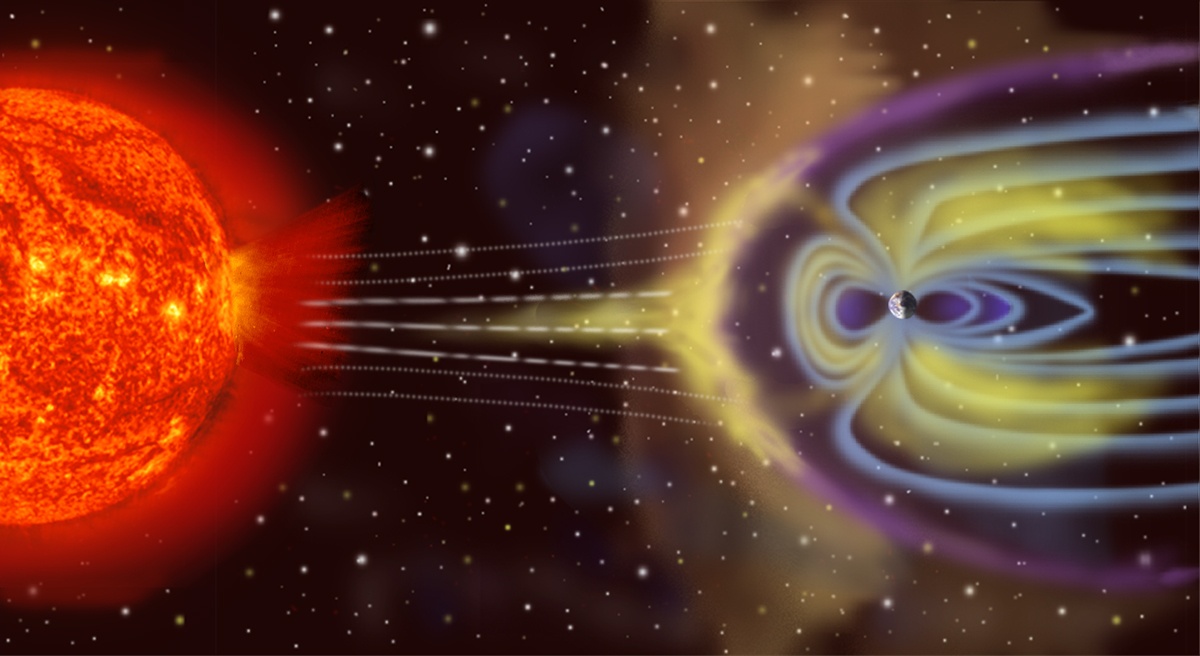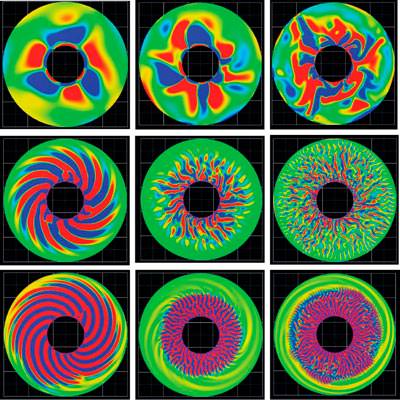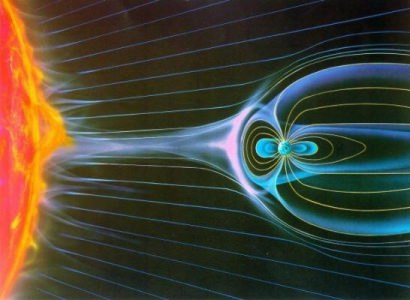Life on Earth would not be possible without food, water, light, a breathable atmosphere and surprisingly, a magnetic field. Without it, Earth, and its inhabitants would be subjected to the harmful radiation from space making life here, impossible. If we find exoplanets with similar magnetospheres then those worlds may well be habitable. The Square Kilometer Array (SKA) which is still under construction should be able to detect such magnetospheres from radio emissions giving us real insight into our exoplanet cousins.
Continue reading “Measuring Exoplanetary Magnetospheres with the Square Kilometer Array”Did the Moon’s Water Come from Earth?

A recent study published in Nature Astronomy examines how processes within the Earth’s magnetic field could be contributing to the formation of water on the surface of the Moon. This study was led by the University of Hawai’i (UH) and comes during an increased interest in finding water ice across the lunar surface, which has previously been confirmed to exist within the permanently shadowed regions (PSRs) of the lunar north and south poles due to the Moon’s small axial tilt of only 1.5 degrees compared to the Earth’s 23.5 degrees. Additionally, better understanding the lunar surface water content could also help scientists gain better insights into the Moon’s formation and evolution, which is currently hypothesized to have formed from a Mars-sized object colliding with the Earth approximately 4.5 billion years ago, or approximately 100 million years after the Earth formed.
Continue reading “Did the Moon’s Water Come from Earth?”NASA Undeterred by the Threat of Space Radiation

When it comes to planning missions to Mars and other distant locations in the Solar System, the threat posed by radiation has become something of an elephant in the room. Whether it is NASA’s proposed “Journey to Mars“, SpaceX’s plans to conduct regular flights to Mars, or any other plan to send crewed missions beyond Low Earth Orbit (LEO), long-term exposure to space radiation and the health risks this poses is an undeniable problem.
But as the old saying goes, “for every problem, there is a solution”; not to mention, “necessity is the mother of invention”. And as representatives from NASA’s Human Research Program recently indicated, the challenge posed by space radiation will not deter the agency from its exploration goals. Between radiation shielding and efforts aimed at mitigation, NASA plans to proceed with mission to Mars and beyond.
Since the beginning of the Space Age, scientists have understood how beyond Earth’s magnetic field, space is permeated by radiation. This includes Galactic Cosmic Rays (GCRs), Solar Particle Events (SPEs) and the Van Allen Radiation Belts, which contains trapped space radiation. Much has also been learned through the ISS, which continues to provide opportunities to study the effects of exposure to space radiation and microgravity.

For instance, though it orbits within Earth’s magnetic field, astronauts receive over ten times the amount of radiation than people experience on average here on Earth. NASA is able to protect crews from SPEs by advising them to seek shelter in more heavily shielded areas of the station – such as the Russian-built Zvezda service module or the US-built Destiny laboratory.
However, GCRs are more of a challenge. These energetic particles, which are primarily composed of high-energy protons and atomic nuclei, can come from anywhere within our galaxy and are capable of penetrating even metal. To make matters worse, when these particles cut through material, they generate a cascade reaction of particles, sending neutrons, protons and other particles in all directions.
This “secondary radiation” can sometimes be a greater risk than the GCRs themselves. And recent studies have indicated that the threat they pose to living tissue can also have a cascading effect, where damage to one cell can then spread to others. As Dr. Lisa Simonsen, a Space Radiation Element Scientist with NASA’s HRP, explained:
“One of the most challenging parts for the human journey to Mars is the risk of radiation exposure and the inflight and long-term health consequences of the exposure. This ionizing radiation travels through living tissues, depositing energy that causes structural damage to DNA and alters many cellular processes.”
To address this risk, NASA is currently evaluating various materials and concepts to shield crews from GCRs. These materials will become an integral part of future deep-space missions. Experiments involving these materials and their incorporation into transport vehicles, habitats and space suits are currently taking place at the NASA Space Radiation Laboratory (NSRL).
At the same time, NASA is also investigating pharmaceutical countermeasures, which could prove to be more effective than radiation shielding. For instance, potassium iodide, diethylenetriamine pentaacietic acid (DTPA) and the dye known as “Prussian blue” have been used for decades to treat radiation sickness. During long-term missions, astronauts will likely need to take daily doses of radiation meds to mitigate exposure to radiation.
Space radiation detection and mitigation technologies are also being developed through NASA’s Advanced Exploration Systems Division. These include the Hybrid Electronic Radiation Assessor for the Orion spacecraft, and a series of personal and operational dosimeters for the ISS. There are also existing instruments which are expected to play an important role when crewed mission to Mars begin.
Who can forget the Radiation Assessment Detector (RAD), which was one of the first instruments sent to Mars for the specific purpose of informing future human exploration efforts. This instrument is responsible for identifying and measuring radiation on the Martian surface, be it radiation from space or secondary radiation produced by cosmic rays interacting with the Martian atmosphere and surface.
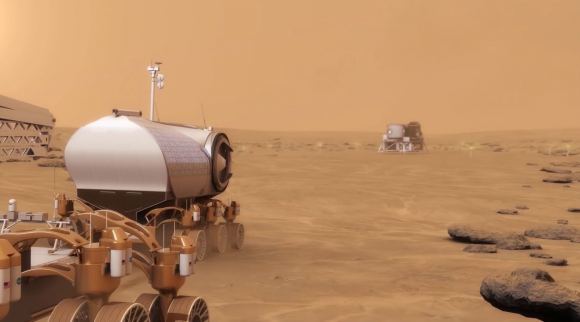
Because of these and other preparations, many at NASA are naturally hopeful that the risks of space radiation can and will be addressed. As Pat Troutman, the NASA Human Exploration Strategic Analysis Lead, stated in a recent NASA press statement:
“Some people think that radiation will keep NASA from sending people to Mars, but that’s not the current situation. When we add the various mitigation techniques up, we are optimistic it will lead to a successful Mars mission with a healthy crew that will live a very long and productive life after they return to Earth.
Scientists are also engaged in ongoing studies of space weather in order to develop better forecasting tools and countermeasures. Last, but not least, multiple organizations are looking to develop smaller, faster spacecraft in order to reduce travel times (and hence, exposure to radiation). Taken together, all of these strategies are necessary for long-duration spaceflights to Mars and other locations throughout the Solar System.
Granted, there is still considerable research that needs to be done before we can say with any certainty that crewed missions to Mars and beyond will be safe, or at least not pose any unmanageable risks. But the fact that NASA is busy addressing these needs from multiple angles demonstrates how committed they are to seeing such a mission happen in the coming decades.

“Mars is the best option we have right now for expanding long-term, human presence,” said Troutman. “We’ve already found valuable resources for sustaining humans, such as water ice just below the surface and past geological and climate evidence that Mars at one time had conditions suitable for life. What we learn about Mars will tell us more about Earth’s past and future and may help answer whether life exists beyond our planet.”
Beyond NASA, Roscosmos, the Chinese National Space Agency (CSNA) have also expressed interest in conducting crewed mission to the Red Planet, possibly between the 2040s or as late as the 2060s. While the European Space Agency (ESA) has no active plans for sending astronauts to Mars, they see the establishment of an International Lunar Village as a major step towards that goal.
Beyond the public sector, companies like SpaceX and non-profits like MarsOne are also investigating possible strategies for protecting and mitigating against space radiation. Elon Musk has been quite vocal (especially of late) about his plans to conduct regular trips to Mars in the near future using the Interplanetary Transport System (ITS) – also known as the BFR – not to mention establishing a colony on the planet.
And Baas Landsdorp has indicated that the organization he founded to establish a human presence on Mars will find ways to address the threat posed by radiation, regardless of what a certain report from MIT says! Regardless of the challenges, there is simply no shortage of people who want to see humanity go to Mars, and possibly even stay there!
And be sure to check out this video about the Human Research Program, courtesy of NASA:
Further Reading: NASA
Let’s Clean up the Space Junk with Magnetic Space Tugs
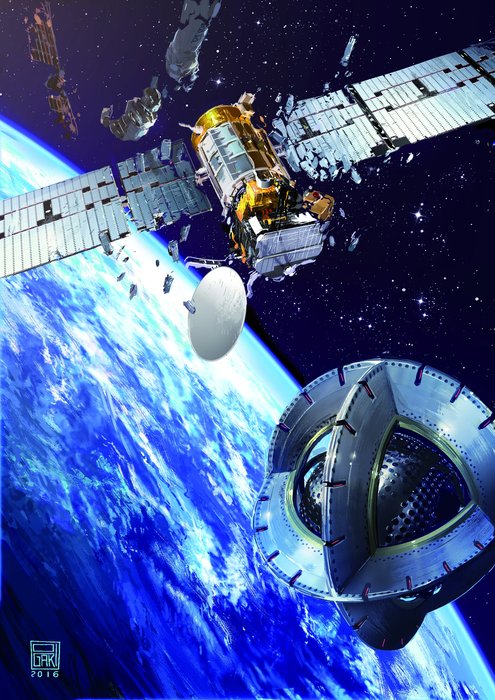
After 50 years of sending rockets, satellites, and payloads into orbit, humanity has created something of a “space junk” problem. Recent estimates indicate that there are more than 170 million pieces of debris up there, ranging in size from less than 1 cm (0.4 in) to a few meters in diameter. Not only does this junk threaten spacecraft and the ISS, but collisions between bits of debris can cause more to form, a phenomena known as the Kessler Effect.
And thanks to the growth of the commercial aerospace industry and the development of small satellites, things are not likely to get any less cluttered up there anytime soon. Hence why multiple strategies are being explored to clean up the space lanes, ranging from robotic arms and nets to harpoons. But in what may be the most ambitious plan to date, the ESA has proposed creating space tugs with powerful magnets to yank debris out of orbit.
The concept comes from Emilien Fabacher, a researcher from the Institut Supérieur de l’Aéronautique et de l’Espace at the University of Toulouse, France. His concept for a magnetic tug seeks to address one type of space debris in particular – inoperable satellites. These uncontrolled, rapidly spinning objects often weigh up to several tons, and are therefore one of the most significant collision hazards there is.

When applied to the problem of orbital debris, magnetic attraction is an attractive solutions for the safe deorbiting of spent satellites. For starters, it relies on technology that is standard issue aboard many low-orbiting satellites, which is known as magnetorquers. These electromagnets allow satellites to adjust their orientation using the Earth’s magnetic field. Hence, debris-chasing satellites would not need to be specially equipped in advance.
What’s more, this same magnetic attraction or repulsion technology is being considered as a safe method for allowing multiple satellites to maintain close formations in space. Such satellites – like NASA’s Magnetospheric Multiscale mission (MMS), the Landsat 7 and the Earth Observing-1 satellites, and the ESA’s upcoming LISA mission – are either operational or soon will be around Earth.
Because of this, this kind of magnetic attraction technology presents a safe and effective alternative for deorbiting space junk. As Fabacher explained in a recent ESA press release:
“With a satellite you want to deorbit, it’s much better if you can stay at a safe distance, without needing to come into direct contact and risking damage to both chaser and target satellites. So the idea I’m investigating is to apply magnetic forces either to attract or repel the target satellite, to shift its orbit or deorbit it entirely.”

The concept emerged out of a conversation Fabacher had with experts from the ESA’s technical center in the Netherlands. As part of his PhD research, he was looking into how magnetic guidance, navigation and control techniques would work in practice. This led to a discussion about how similar technology could allow swarms of satellites to attract and remove debris from orbit.
After making some calculations that combined a rendezvous simulator with magnetic interaction models, and also taking account the ever-changing state of Earth’s own magnetosphere, Fabacher and his colleagues realized they had a working concept. “The first surprise was that it was indeed possible, theoretically – initially we couldn’t be sure, but it turns out that the physics works fine,” he said.
To break it down, the chaser satellites would generate a strong magnetic field using superconducting wires that are cooled to cryogenic temperatures. These satellites would also rely on magnetic fields to maintain precise flying formations, thus allowing a swarm of chaser satellites the ability to deal with multiple pieces of debris, or to coordinate and guide debris to a specific location.
According to Finn Ankersen – an ESA expert in rendezvous and docking and formation flight – these magnetic tugs would also be able to remove space debris with a very high level of precision. “This kind of contactless magnetic influence would work from about 10–15 meters out, offering positioning precision within 10 cm with attitude precision [of] 1 – 2º,” he said.

The concept is being developed with support provided by the ESA’s Networking/Partnering Initiative, a program that offers support to universities and research institutes for the sake of developing space-related technologies. And it comes at a time when the issue of space debris is becoming increasingly worrisome.
Left unchecked, space debris is likely to become a very serious hazard in the coming years and decades. Already, it is estimated that the small satellite market will grow by $5.3 billion in the next decade (according to Space Works and Eurostat) and many private companies are looking to provide regular launch services to accommodate that growth.
If we intend to begin making a return to the Moon and mounting missions to Mars, we need to make sure the space lanes are clear! And given the importance of the International Space Station to scientific research and international collaboration, and with companies like Bigelow Aerospace looking to establish space habitats in orbit, something has to be done about this problem before it gets completely out of control!
Who knows? Maybe a small fleet or magnetic tugs is just what we need to clean up this mess!
Further Reading: ESA
Exploring the Universe For Magnetic Fields

In the past few decades, astronomers and geophysicists have benefited immensely from the study of planetary magnetic fields. Dedicated to mapping patterns of magnetism on other astronomical bodies, this field has grown thanks to missions ranging from the Voyager probes to the more recent Mars Atmosphere and Volatile EvolutioN (MAVEN) mission.
Looking ahead, it is clear that this field of study will play a vital role in the exploration of the Solar System and beyond. As Jared Espley of NASA’s Goddard Space Flight Center outlined during a presentation at NASA’s Planetary Science Vision 2050 Workshop, these goals include advancing human exploration of the cosmos and the search for extraterrestrial life.
Continue reading “Exploring the Universe For Magnetic Fields”This is Actual Science. Crystals at the Earth’s Core Power its Magnetic Field

Whether or not a planet has a magnetic field goes a long way towards determining whether or not it is habitable. Whereas Earth has a strong magnetosphere that protects life from harmful radiation and keeps solar wind from stripping away its atmosphere, planet’s like Mars no longer do. Hence why it went from being a world with a thicker atmosphere and liquid water on its surface to the cold, desiccated place it is today.
For this reason, scientists have long sought to understand what powers Earth’s magnetic field. Until now, the consensus has been that it was the dynamo effect created by Earth’s liquid outer core spinning in the opposite direction of Earth’s rotation. However, new research from the Tokyo Institute of Technology suggests that it may actually be due to the presence of crystallization in the Earth’s core.
The research was conducted by scientists from the Earth-Life Science Institute (ELSI) at Tokyo Tech. According to their study – titled “Crystallization of Silicon Dioxide and Compositional Evolution of the Earth’s Core“, which appeared recently in Nature – the energy that drives the Earth’s magnetic field may have more to do with the chemical composition of the Earth’s core.

Of particular concern for the research team was the rate of which Earth’s core cools over geological time – which has been the subject of debate for some time. And for Dr. Kei Hirose – the director of the Earth-Life Science Institute and lead author on the paper – it has been something of a lifelong pursuit. In a 2013 study, he shared research findings that indicated how the Earth’s core may have cooled more significantly than previously thought.
He and his team concluded that since the Earth’s formation (4.5 billion years ago), the core may have cooled by as much as 1,000 °C (1,832 °F). These findings were rather surprising to the Earth sciences community – leading to what one scientists referred to as the “New Core Heat Paradox“. In short, this rate of core cooling would mean that some other source of energy would be required to sustain the Earth’s geomagnetic field.
On top of this, and related to the issue of core-cooling, were some unresolved questions about the chemical composition of the core. As Dr. Kei Hirose said in a Tokyo Tech press release:
“The core is mostly iron and some nickel, but also contains about 10% of light alloys such as silicon, oxygen, sulfur, carbon, hydrogen, and other compounds. We think that many alloys are simultaneously present, but we don’t know the proportion of each candidate element.”

In order to resolve this, Hirose and his colleagues at ELSI conducted a series of experiments where various alloys were subjected to heat and pressure conditions similar to that in the Earth’s interior. This consisted of using a diamond anvil to squeeze dust-sized alloy samples to simulate high pressure conditions, and then heating them with a laser beam until they reached extreme temperatures.
In the past, research into iron alloys in the core have focused predominantly on either iron-silicon alloys or iron-oxide at high pressures. But for the sake of their experiments, Hirose and his colleagues decided to focus on the combination of silicon and oxygen – which are believed to exist in the outer core – and examining the results with an electron microscope.
What the researchers found was that under conditions of extreme pressure and heat, samples of silicon and oxygen combined to form silicon dioxide crystals – which were similar in composition to mineral quartz found in the Earth’s crust. Ergo, the study showed that the crystallization of silicon dioxide in the outer core would have released enough buoyancy to power core convection and a dynamo effect from as early on as the Hadean eon onward.
As John Hernlund, also a member of ELSI and a co-author of the study, explained:
“This result proved important for understanding the energetics and evolution of the core. We were excited because our calculations showed that crystallization of silicon dioxide crystals from the core could provide an immense new energy source for powering the Earth’s magnetic field.”

This study not only provides evidence to help resolve the so-called “New Core Heat Paradox”, it also may help advance our understanding of what conditions were like during the formation of Earth and the early Solar System. Basically, if silicon and oxygen form crystal of silicon dioxide in the outer core over time, then sooner or later, the process will stop once the core runs out of these elements.
When that happens, we can expect Earth’s magnetic field will suffer, which will have drastic implications for life on Earth. It also helps to put constraints on the concentrations of silicon and oxygen that were present in the core when the Earth first formed, which could go a long way towards informing our theories about Solar System formation.
What’s more, this research may help geophysicists to determine how and when other planets (like Mars, Venus and Mercury) still had magnetic fields (and possibly lead to ideas of how they could be powered up again). It could even help exoplanet-hunting science teams determine which exoplanets have magnetospheres, which would allow us to find out which extra-solar worlds could be habitable.
Further Reading: Tokyo Tech News, Nature.
Does Zonal Swishing Play a Part in Earth’s Magnetic Field Reversals?
[/caption]
Why does the Earth’s magnetic field ‘flip’ every million years or so? Whatever the reason, or reasons, the way the liquid iron of the Earth’s outer core flows – its currents, its structure, its long-term cycles – is important, either as cause, effect, or a bit of both.
The main component of the Earth’s field – which defines the magnetic poles – is a dipole generated by the convection of molten nickel-iron in the outer core (the inner core is solid, so its role is secondary; remember that the Earth’s core is well above the Curie temperature, so the iron is not ferromagnetic).
But what about the fine structure? Does the outer core have the equivalent of the Earth’s atmosphere’s jet streams, for example? Recent research by a team of geophysicists in Japan sheds some light on these questions, and so hints at what causes magnetic pole flips.
About the image: This image shows how an imaginary particle suspended in the liquid iron outer core of the Earth tends to flow in zones even when conditions in the geodynamo are varied. The colors represent the vorticity or “amount of rotation” that this particle experiences, where red signifies positive (east-west) flow and blue signifies negative (west-east) flow. Left to right shows how the flow responds to increasing Rayleigh numbers, which is associated with flow driven by buoyancy. Top to bottom shows how flow responds to increasing angular velocities of the whole geodynamo system.
The jet stream winds that circle the globe and those in the atmospheres of the gas giants (Jupiter, Saturn, etc) are examples of zonal flows. “A common feature of these zonal flows is that they are spontaneously generated in turbulent systems. Because the Earth’s outer core is believed to be in a turbulent state, it is possible that there is zonal flow in the liquid iron of the outer core,” Akira Kageyama at Kobe University and colleagues say, in their recent Nature paper. The team found a secondary flow pattern when they modeled the geodynamo – which generates the Earth’s magnetic field – to build a more detailed picture of convection in the Earth’s outer core, a secondary flow pattern consisting of inner sheet-like radial plumes, surrounded by westward cylindrical zonal flow.
This work was carried out using the Earth Simulator supercomputer, based in Japan, which offered sufficient spatial resolution to determine these secondary effects. Kageyama and his team also confirmed, using a numerical model, that this dual-convection structure can co-exist with the dominant convection that generates the north and south poles; this is a critical consistency check on their models, “We numerically confirm that the dual-convection structure with such a zonal flow is stable under a strong, self-generated dipole magnetic field,” they write.
This kind of zonal flow in the outer core has not been seen in geodynamo models before, due largely to lack of sufficient resolution in earlier models. What role these zonal flows play in the reversal of the Earth’s magnetic field is one area of research that Kageyama and his team’s results that will now be able to be pursued.
Sources: Physics World, based on a paper in the 11 February, 2010 issue of Nature. Earth Simulator homepage
Cluster Satellite Detects Rifts in Earth’s Magnetic Field
[/caption]
While Earth’s magnetic field protects our planet from most of the permanent flow of particles from the solar wind, rifts or fissures in natural shield are known to occur, enabling the solar wind to penetrate our near-space environment. An ESA satellite cluster called, appropriately, Cluster has provided new insight into the location and duration of these ruptures in the Earth’s magnetic shield, and reveals while our atmosphere protects us for the most part, clear effects of these rifts have been detected high in the upper atmosphere and in the region of space around Earth where satellites orbit.
This study reports the observation of fissures on the Sun-facing side of the Earth’s magnetic shield – the dayside magnetopause. Fortunately, these fissures don’t expose Earth’s surface to the solar wind; our atmosphere protects us. But the upper atmosphere is affected. ,

The dominant physical process causing these cracks is known as magnetic reconnection, a process whereby magnetic field lines from different magnetic domains collide and reconnect: opening the closed magnetic shield. Magnetic reconnection is a physical process at work throughout the Universe, from star formation to solar explosions to experimental fusion reactors on Earth. However, the conditions under which it occurs and how long it lasts remain unclear.
What is known is that magnetic reconnection leads to the mixing of previously separated plasmas when, for instance, the solar wind plasma enters the magnetosphere. In this instance the two magnetic domains are the Earth’s internal magnetic field, and the interplanetary magnetic field (IMF). (The solar wind is not only composed of solar particles (mostly protons and electrons), it also carries the Sun’s magnetic field. Out among the planets, this field is the IMF.)
For more than 700,000 years, the South to North orientation of the terrestrial magnetic field has been rather steady. In contrast, the IMF orientation is highly variable, with total inversion frequently observed on times-scales of minutes.
Reconnection between the IMF and the Earth’s magnetic field critically depends on the angle between these fields. Space physicists have made a distinction between reconnection when both fields are in opposite directions, or anti-parallel, and component reconnection, when the IMF is neither parallel nor anti-parallel to the terrestrial magnetic field. The distinction is important since component and anti-parallel reconnection have different onset characteristics and lead to different duration of the fissures in the magnetic shield. The distinction between these two types of magnetic reconnection has been the subject of hot debate among space scientists for many years.

For the first time, four spacecraft flying in constellation (the ESA Cluster mission), have provided unambiguous evidence of anti-parallel reconnection at high latitude on the dayside magnetopause, occurring quasi-simultaneously with a period of low-latitude component reconnection detected by the Sino-European Double Star TC-1 satellite. TC-1 and the Cluster array (with the Cluster spacecraft separated by ~2000 km) are more than 30,000 km apart (see below.) The 3D reconnection picture, determined by repeated sampling of the ion diffusion region and associated magnetic null fields (i.e. the heart of the reconnection process). 2.
“These observations support the idea that both anti-parallel and component reconnection occur at the dayside magnetopause under the same IMF conditions and that both phenomena might be the local signatures of a global reconnection picture”, says Professor Malcolm Dunlop from the Rutherford Appleton Laboratory, Didcot, UK.
“This remarkable set of observations shows that magnetic reconnection at the magnetopause is not as simple as it is described in textbooks! It also demonstrates the need for the capability to study magnetic reconnection at multiple scales simultaneously”, says Matt Taylor, acting Cluster project scientist at the European Space Agency.
Source: ESA

